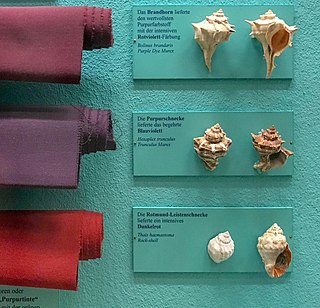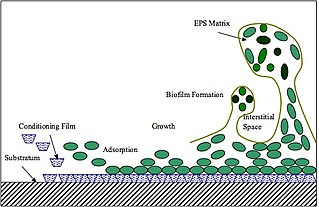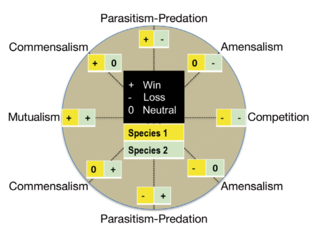Related Research Articles

Tyrian purple, also known as, royal purple, imperial purple, or imperial dye, is a reddish-purple natural dye. The name Tyrian refers to Tyre, Lebanon. It is secreted by several species of predatory sea snails in the family Muricidae, rock snails originally known by the name 'Murex'. In ancient times, extracting this dye involved tens of thousands of snails and substantial labor, and as a result, the dye was highly valued. The colored compound is 6,6′-dibromoindigo.

Murex is a genus of medium to large sized predatory tropical sea snails. These are carnivorous marine gastropod molluscs in the family Muricidae, commonly called "murexes" or "rock snails".

Mucus is a slippery aqueous secretion produced by, and covering, mucous membranes. It is typically produced from cells found in mucous glands, although it may also originate from mixed glands, which contain both serous and mucous cells. It is a viscous colloid containing inorganic salts, antimicrobial enzymes, immunoglobulins, and glycoproteins such as lactoferrin and mucins, which are produced by goblet cells in the mucous membranes and submucosal glands. Mucus serves to protect epithelial cells in the linings of the respiratory, digestive, and urogenital systems, and structures in the visual and auditory systems from pathogenic fungi, bacteria and viruses. Most of the mucus in the body is produced in the gastrointestinal tract.

Hexaplex trunculus is a medium-sized sea snail, a marine gastropod mollusk in the family Muricidae, the murex shells or rock snails. It is included in the subgenus Trunculariopsis.

Muricidae is a large and varied taxonomic family of small to large predatory sea snails, marine gastropod mollusks, commonly known as murex snails or rock snails. With over 1,700 living species, the Muricidae represent almost 10% of the Neogastropoda. Additionally, 1,200 fossil species have been recognized. Numerous subfamilies are recognized, although experts disagree about the subfamily divisions and the definitions of the genera. Many muricids have unusual shells which are considered attractive by shell collectors and by interior designers.

Mucins are a family of high molecular weight, heavily glycosylated proteins (glycoconjugates) produced by epithelial tissues in most animals. Mucins' key characteristic is their ability to form gels; therefore they are a key component in most gel-like secretions, serving functions from lubrication to cell signalling to forming chemical barriers. They often take an inhibitory role. Some mucins are associated with controlling mineralization, including nacre formation in mollusks, calcification in echinoderms and bone formation in vertebrates. They bind to pathogens as part of the immune system. Overexpression of the mucin proteins, especially MUC1, is associated with many types of cancer.

6,6'-Dibromoindigo is an organic compound with the formula (BrC6H3C(O)CNH)2. A deep purple solid, the compound is also known as Tyrian purple, a dye of historic significance. Presently, it is only a curiosity, although the related derivative indigo is of industrial significance. The molecule consists of a pair of monobrominated indole rings linked by a carbon-carbon double bond. It is produced by molluscs of the Muricidae species.

An ink sac is an anatomical feature that is found in many cephalopod mollusks used to produce the defensive cephalopod ink. With the exception of nocturnal and very deep water cephalopods, all Coleoidea which dwell in light conditions have an ink sac, which can be used to expel a cloud of dark ink in order to confuse predators.

Bolinus brandaris, and commonly known as the purple dye murex or the spiny dye-murex, is a species of medium-sized predatory sea snail, an edible marine gastropod mollusk in the family Muricidae, the murex snails or the rock snails.

Dicathais is a genus of predatory sea snails, marine gastropod molluscs in the family Muricidae, the rock snails. This genus is monotypic; the only species in it is Dicathais orbita, common name the white rock shell or cart-rut shell, found round the coasts of Australia and New Zealand.

Extracellular polymeric substances (EPSs) are natural polymers of high molecular weight secreted by microorganisms into their environment. EPSs establish the functional and structural integrity of biofilms, and are considered the fundamental component that determines the physicochemical properties of a biofilm. EPS in the matrix of biofilms provides compositional support and protection of microbial communities from the harsh environments. Components of EPS can be of different classes of polysaccharides, lipids, nucleic acids, proteins, lipopolysaccharides, and minerals.

Concholepas concholepas, the Chilean abalone or Peruvian tolina, is a species of large edible sea snail, a marine gastropod mollusk. Despite the superficial resemblance, C. concholepas is not a true abalone, but a member of the family Muricidae, also known as murex snails or rock snails. This species is native to the coasts of Chile and Peru, where it is called loco, pata de burro, tolina, or chanque.

Mollusca is the second-largest phylum of invertebrate animals, after the Arthropoda; members are known as molluscs or mollusks. Around 76,000 extant species of molluscs are recognized. The number of fossil species is estimated between 60,000 and 100,000 additional species. The proportion of undescribed species is very high. Many taxa remain poorly studied.
Roberto Kolter is Professor of Microbiology, Emeritus at Harvard Medical School, an author, and past president of the American Society for Microbiology. Kolter has been a professor at Harvard Medical School since 1983 and was Co-director of Harvard's Microbial Sciences Initiative from 2003-2018. During the 35-year term of the Kolter laboratory from 1983 to 2018, more than 130 graduate student and postdoctoral trainees explored an eclectic mix of topics gravitating around the study of microbes. Kolter is a fellow of the American Association for the Advancement of Science and of the American Academy of Microbiology.

Bolinus cornutus, or horned murex, is a predatory species of sea snail, a marine gastropod mollusk in the family Muricidae, the murex or rock snails. This species is common along the west coast of Africa, where it prefers moderately shallow waters. The shell of the snail is distinctively large, spiny, and club-shaped, usually pale brown or tan in colour, with an elongated and straight siphonal canal.
Plicopurpura pansa is a species of sea snail, a marine gastropod mollusk in the family Muricidae, the murex snails or rock snails.

Snail slime (mucopolysaccharide) is a kind of mucus produced by snails, which are gastropod mollusks. Land snails and slugs both produce mucus, as does every other kind of gastropod, from marine, freshwater, and terrestrial habitats. The reproductive system of gastropods also produces mucus internally from special glands.

Bromide peroxidase (EC 1.11.1.18, bromoperoxidase, haloperoxidase (ambiguous), eosinophil peroxidase) is a family of enzymes with systematic name bromide:hydrogen-peroxide oxidoreductase. These enzymes catalyse the following chemical reaction:

Microbial symbiosis in marine animals was not discovered until 1981. In the time following, symbiotic relationships between marine invertebrates and chemoautotrophic bacteria have been found in a variety of ecosystems, ranging from shallow coastal waters to deep-sea hydrothermal vents. Symbiosis is a way for marine organisms to find creative ways to survive in a very dynamic environment. They are different in relation to how dependent the organisms are on each other or how they are associated. It is also considered a selective force behind evolution in some scientific aspects. The symbiotic relationships of organisms has the ability to change behavior, morphology and metabolic pathways. With increased recognition and research, new terminology also arises, such as holobiont, which the relationship between a host and its symbionts as one grouping. Many scientists will look at the hologenome, which is the combined genetic information of the host and its symbionts. These terms are more commonly used to describe microbial symbionts.
Kirsten Benkendorff is a marine scientist who works on molluscs, antibiotics, anti-inflammatory properties and cancer fighting properties. She was awarded Young Australian of the Year in 2000 and a Dorothy Hill Medal for Science in 2011.
References
- ↑ Fretter & Graham, 1962, p. 88
- ↑ Nair, J.R., D. Pillai, S.M. Joseph, P. Gomathi, P.V. Senan & P.M. Sherief (2011). "Cephalopod research and bioactive substances" (PDF).Indian Journal of Geo-Marine Sciences40(1): 13–27.
- ↑ Pontarotti, 2010, p.260
- 1 2 Yonge, C. M. (1947). "The Pallial Organs in the Aspidobranch Gastropoda and their Evolution throughout the Mollusca". Philosophical Transactions of the Royal Society of London. Series B, Biological Sciences. 232 (591): 443–518. Bibcode:1947RSPTB.232..443Y. doi: 10.1098/rstb.1947.0003 . ISSN 0080-4622. JSTOR 92345. PMID 20296045. S2CID 44609586.
- 1 2 3 Yonge, C. M. (1947). "The Pallial Organs in the Aspidobranch Gastropoda and their Evolution throughout the Mollusca". Philosophical Transactions of the Royal Society of London. Series B, Biological Sciences. 232 (591): 443–518. Bibcode:1947RSPTB.232..443Y. doi: 10.1098/rstb.1947.0003 . ISSN 0080-4622. JSTOR 92345. PMID 20296045. S2CID 44609586.
- 1 2 Ngangbam, Ajit Kumar; Baten, Abdul; Waters, Daniel L. E.; Whalan, Steve; Benkendorff, Kirsten (2015-10-21). Balcazar, Jose Luis (ed.). "Characterization of Bacterial Communities Associated with the Tyrian Purple Producing Gland in a Marine Gastropod". PLOS ONE. 10 (10): e0140725. Bibcode:2015PLoSO..1040725N. doi: 10.1371/journal.pone.0140725 . ISSN 1932-6203. PMC 4619447 . PMID 26488885.
- ↑ Benkendorff, Kirsten; Rudd, David; Nongmaithem, Bijayalakshmi; Liu, Lei; Young, Fiona; Edwards, Vicki; Avila, Cathy; Abbott, Catherine (2015-08-18). "Are the Traditional Medical Uses of Muricidae Molluscs Substantiated by Their Pharmacological Properties and Bioactive Compounds?". Marine Drugs. 13 (8): 5237–5275. doi: 10.3390/md13085237 . ISSN 1660-3397. PMC 4557022 . PMID 26295242.
- ↑ Cooksey, Chris (2013). "Tyrian Purple: The First Four Thousand Years". Science Progress. 96 (2): 171–186. doi:10.3184/003685013X13680345111425. ISSN 0036-8504. PMC 10365538 . PMID 23901634. S2CID 1250423.
- 1 2 3 4 5 6 7 8 9 Benkendorff, Kirsten; Rudd, David; Nongmaithem, Bijayalakshmi; Liu, Lei; Young, Fiona; Edwards, Vicki; Avila, Cathy; Abbott, Catherine (2015-08-18). "Are the Traditional Medical Uses of Muricidae Molluscs Substantiated by Their Pharmacological Properties and Bioactive Compounds?". Marine Drugs. 13 (8): 5237–5275. doi: 10.3390/md13085237 . ISSN 1660-3397. PMC 4557022 . PMID 26295242.
- ↑ Ben Mabrouk, Hazem; Nejia, Sayari; Maram, Morjen; Naziha, Marrakchi; Soufia, Chabchoub-Ellouze (2017-10-03). "A New Protein Extract Inhibitor from Hypobranchial Purple Gland of Hexaplex trunculus, a Mediterranean Mollusk, Impairs the Motility of Human Glioblastoma U87 and the HeLa Cell Line of Cervical Carcinoma Cells". Nutrition and Cancer. 69 (7): 1028–1035. doi:10.1080/01635581.2017.1359315. ISSN 0163-5581. PMID 29083237. S2CID 41072897.